
Before I begin writing about my trip, I would like to mention its significance.
Varanasi also known as Benares or Kashi is one of the most holy cities for Hindus and Buddhists. It is known as the spiritual capital of India dating back to 11th century BC. As said, it is older even than a legend. It is believed to be formed on the basis of legend that it was made by Lord Shiva in 3000 BC. It is believed to be one of the homes of Lord Shiva. The city gets Hindu pilgrims from different parts of the world. The city has around 2000 temples. Adi Shankara has established worship of shiva as an official sect of Varanasi.
Major personalities like Kabir and Ravidas were born here.
Buddha has given his first sermon “motion of the wheel of Dharma at the nearby Sarnath in 528 BCE (must see archeological site).
Tulsidas wrote Ramcharitmanas in Varanasi.
There are approx. 88 ghats (ghats in Varanasi are riverfront steps leading to the banks of river Ganges) with holy myth associated with their origin. The place has the oldest Hindu university (BHU). It has oldest Sanskrit college from where my grandfather studied in late 1930s.
Hindus believe that one who is graced to die on the land of Varanasi would attain salvation and freedom from the cycle of birth and rebirth. Ganges in Varanasi is believed to have the power to wash away the sins of mortals.
Here are the details on what I covered in my 3 days trip to Varanasi:
Three days are more than enough to tour the 2 pilgrimages.
Day 1:
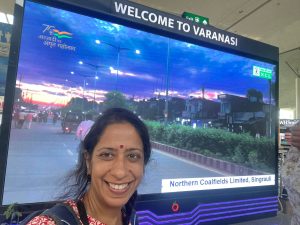
- We started our journey from New Delhi Indira Gandhi International Airport to Lal Bahadur Shastri International Airport in Varanasi.
- We stayed in Hotel Radisson. It is one of the centrally located hotel within the proximity to Ghats. The restaurant of the hotel has beautiful menu book which define culture and heritage of the city.
- In the evening we hired taxi. It dropped us to a point and we walked towards Dashawamedh Ghat via Bengali Tola walk. The Ghat is famous for evening Ganga Aarti(prayer). It is one of the most spectacular religious or devotional rituals carried out in the world. We covered many ghats in the boat ride and understood its significance.

The city has vibes of old era. We had famous street food tomato chat, golgappas, tikki chaat on the way back. The street has narrow alleys, and it gives you an opportunity to acclimatize with the culture and understand how people lived here thousands of years back. There are some Ashrams along the way where the monks & the pilgrims stay.

Day 2:
- In the First half we covered one of the most ancient Kaal Bhairav temple. Kal Bhairav is believed to be the kotwal or Chief police officer of Lord Shiva.
- Then we reached the famous Hindu temple that is Kashi Vishwanath(which means lord of the universe or Shiva). The temple has Jyotirlinga (word is a sanskrit compound of jyotis’ radiance’ and linga. The great legend is associated with its creation as in one of the holy book Shiv Puranas.
- Then we visited Vishalakshi Temple (first wife of Lord Shiva.
- After that we visited Annapurna temple (Annapurna is the Hindu Goddess for nourishment and is a form of the Goddess Parvati.
All these temples are in one campus and can be visited at the same time.
- Then I did the ritualistic dip in the holy water Ganga at the Mira Ghat

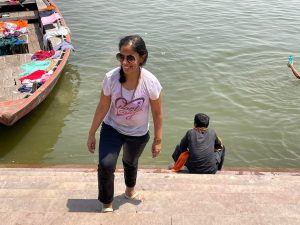
- Quickly we covered Sampurnanand Sanskrit University (established in 1791)
- Then we tried tried street food black chana kachori and local tea in purava (kulad). as said UP (state in India) to clay cup.

- Bought famous Indian traditional mud toys for Aadya (my 5 year old daughter)

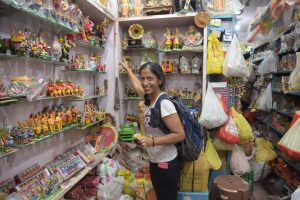
The best part of it is that same thing is said in different ways in different state of India because the dialect or language changes within the country.
Second Half:
Good to meet tourists coming from all over the world to visit the historical and spiritual city. Talked to Turkish ladies who were staying next door in the hotel. Good to know that foreign tourists have studied so much about India.
In the evening we visited:
- Varanasi’s famous Tambulam Paan shop.
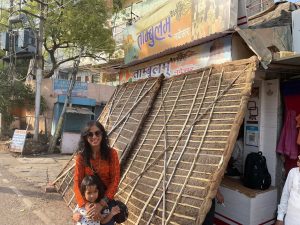
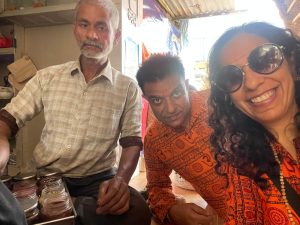
- #bharatmatamandir which has a huge map of undivided India carved in marble. It is dedicated to Bharat Mata and claims to be the only one of its kind in the world. It was constructed by freedom fighter Shivprasad Gupta and was inaugurated by Mahatma Gandhi himself in 1930.
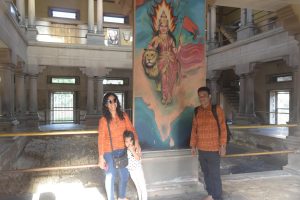
- BHU(Banaras Hindu University established in 1916 #centreofvedicscience. It is one of the largest residential university in Asia. The university is one of the ten public universities declared as an Institute of Eminence),
- Tridev temple (The shrine is dedicated to three deities….Salasar Hanuman, Rani Sati Dadi and Khatu Shyam)…Sankat Mochan Temple (“Sankat Mochan” meaning the “reliever from troubles”) which is dedicated to the God Hanuman. The temple was established by famous Hindu preacher and poet saint Tulsidas in the early 16th century and is situated on the banks of the Assi river…
- Tulsi Manas Temple- This temple has great historical and cultural importance in Hinduism since the ancient Hindu epic Ramcharitmanas was originally written at this place by Hindu poet-saint, reformer and philosopher Tulsidas in 16th century.
- Tried famous Banarasi sweets #kheerkadam #lalpeda .
Towards the end of our trip that is the 3rd day Visited
- Visited second Buddist pilgrimage in Sarnath (my first was Lumbini in Nepal).
- Visited archeological site stupa (shrine) and the famous lion-capital memorial pillar, which was erected by the 3rd-century-BC Mauryan emperor Ashoka and is now the state emblem of India.
- Chaukhandi Stupa was built during the Gupta period between the 4th and 6th centuries to mark the site where Buddha and his first disciples met traveling from Bodh Gaya to Sarnath.
- Then we met local silk weavers and Handloom weaving. Weaving is typically done within the household, and most weavers in Varanasi are Muslims (The history of Indian sarees dates back to the Hindu mythology of Ramayana in the 1000 to 300 B.C. Banarasi silk was introduced in India by the Mughal Empire with its intricate weaving and designing craftsmanship)
- Then we walked to the family home of Lal Bahadur Shastri second Prime Minister of India which was converted into museum. We understood his simple lifestyle.
We visited #ramnagarfort as well.
- Concluded the day with highly recommended not to miss highly recommended malai rabri lassi… at Ramnagar shop name #shivprasadlassi yummy yummy had two rounds.
On our day of departure
- Early morning – Watched sunrise at 5:30am and Ganga Aarti (prayer…Vedic chants, raga, and yoga) at Assi Ghat and had a holy dip in river Ganga with #Suryanamaskar….at #assighat
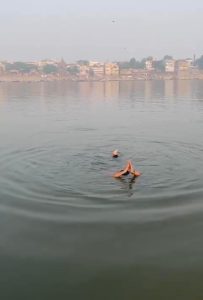
2.Visited #srirambhandar highly recommended sweet shop.
Some street food shops are open between 3am-4am. People are early risers in Varanasi.
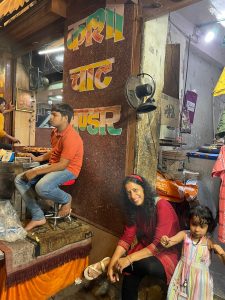
Then we left for airport around 11am.
If you are a spiritual reader I highly recommend bookstore in Varanasi Airport. Mainly the books are based on yoga of mind, spirituality, religion etc.
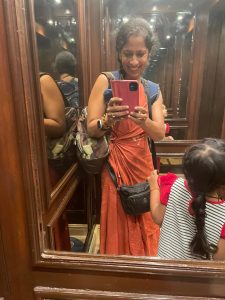
I came across wonderful and rare painting at Varanasi Airport which depicted Ghats n 7 priests performing Ganga Aarti but most of the silk handloom tapestries in Varanasi shops are based on Radha n Krishna.



Recent Comments